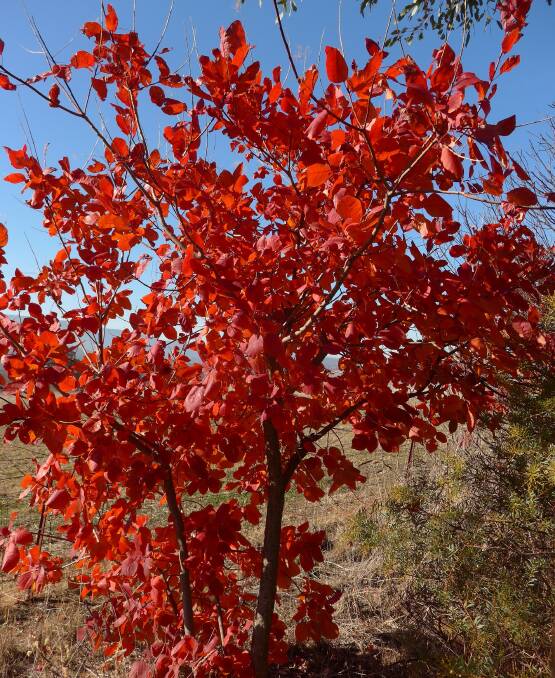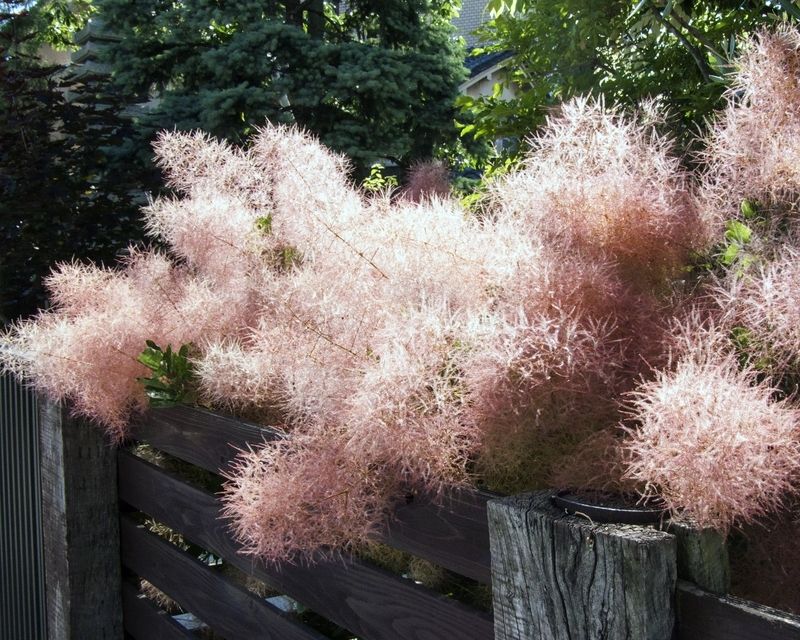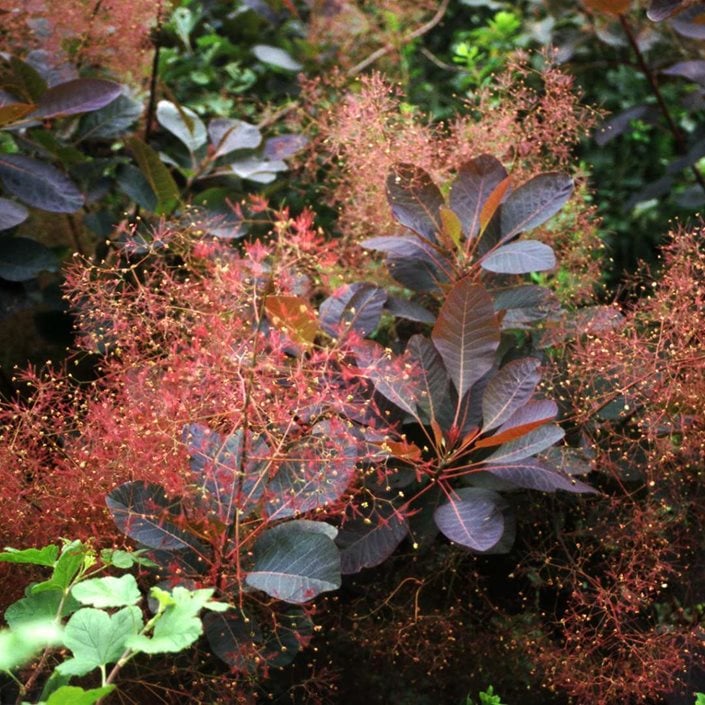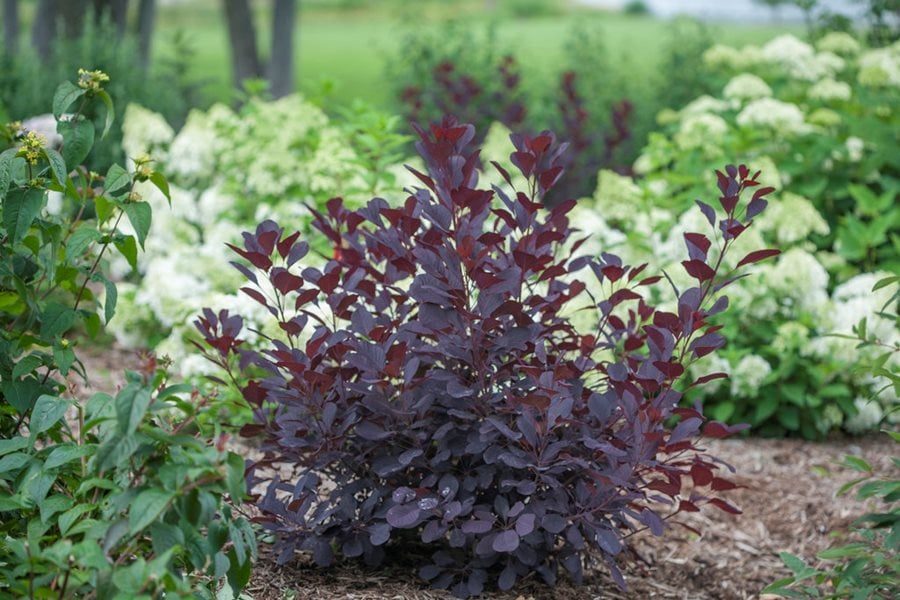How To Grow A Smoke Bush Tree For Stunning Fall Foliage
Smoke bush trees (Cotinus coggygria) are known for their beautiful fall foliage, which can range in color from deep purple to orange to red. These trees are relatively easy to grow and care for, and they can add a touch of elegance to any landscape.
Choosing a Location
Smoke bush trees prefer full sun, but they can tolerate some light shade. They are also adaptable to a variety of soil types, but they prefer well-drained soil. When choosing a location for your smoke bush tree, make sure to choose a spot that gets at least six hours of sunlight per day.
Planting
Smoke bush trees can be planted in the spring or fall. When planting, dig a hole that is twice as wide and as deep as the root ball of the tree. Backfill the hole with soil, tamping it down firmly. Water the tree well after planting.
Watering
Smoke bush trees are relatively drought-tolerant once established, but they will need regular watering during their first year in the ground. Water deeply and thoroughly once a week, or more often during hot, dry weather.
Fertilizing
Smoke bush trees do not need a lot of fertilizer. A light application of compost in the spring will provide them with all the nutrients they need. You can also fertilize them with a balanced fertilizer once a year in the spring.
Pruning
Smoke bush trees do not require a lot of pruning. You can simply remove any dead, diseased, or damaged branches in the spring. You can also prune them to shape them or to control their size.
Fall Foliage
Smoke bush trees typically start to turn color in late September or October. The exact color of the foliage will depend on the variety of smoke bush tree you have. Some popular varieties include:
- Purple Smoke Bush: This variety has deep purple foliage that turns a brilliant red in the fall.
- Silver Cloud Smoke Bush: This variety has green foliage that turns a pale yellow in the fall.
- Gold Dust Smoke Bush: This variety has yellow foliage that turns orange in the fall.
Companion Plants
Smoke bush trees can be planted in a variety of settings. They make beautiful specimen plants, and they can also be used to create borders or screens. Some good companion plants for smoke bush trees include:
- Viburnum: These shrubs offer beautiful flowers and berries in the spring and summer.
- Ninebark: This shrub has colorful bark and attractive foliage.
- Tickseed: This perennial wildflower has bright yellow flowers in the summer.
- Ornamental grasses: These grasses add texture and movement to the landscape.
- Spirea: These shrubs have showy flowers in the spring.
- Weigela: These shrubs have beautiful flowers in the spring and summer.
- Black-eyed Susan: This perennial wildflower has bright yellow flowers in the summer.
- Helenium: This perennial wildflower has bright orange flowers in the summer.
Conclusion
Smoke bush trees are a beautiful and easy-to-grow addition to any landscape. With their stunning fall foliage, smoke bush trees can add a touch of elegance to your yard.
Smoke bush trees are beautiful and versatile plants that can add a touch of elegance to any garden. They are known for their delicate, smoky pink flowers that bloom in the summer, and their colorful fall foliage. Smoke bush trees are relatively easy to care for and can thrive in a variety of conditions.
If you are interested in learning more about smoke bush trees, please visit Home Gardening. This website has a wealth of information about smoke bush trees, including care tips, planting instructions, and variety descriptions. You can also find photos of smoke bush trees in bloom and in fall.
FAQ of smoke bush tree
- How do I identify a smoke bush tree?
Smoke bush trees are known for their feathery, pinkish-purple foliage that blooms in the summer. They can grow up to 15 feet tall and wide, and have a medium growth rate. The stems of smoke bush trees are purple to brown and covered with a waxy bloom. Older bark is light gray and in small blocks. Flowers are small and yellow-green occurring in large terminal panicles (6-8").
- How to plant a smoke bush tree?
Smoke bush trees should be planted in full sun or partial shade in well-drained soil. They are not very tolerant of wet or poorly draining soils. The best time to plant smoke bush trees is in the spring or fall. When planting, dig a hole that is twice as wide as the root ball of the tree. Amend the soil with compost or other organic matter. Place the tree in the hole and backfill with soil, tamping down gently to remove air pockets. Water the tree thoroughly.
- How to care for a smoke bush tree?
Smoke bush trees are relatively low-maintenance plants. They need to be watered regularly, especially during the first year after planting. They should also be fertilized once a year in the spring with a balanced fertilizer. Smoke bush trees are not very susceptible to pests or diseases.
- How to propagate a smoke bush tree?
Smoke bush trees can be propagated by stem cuttings or seeds. Stem cuttings are the most common method. To take a stem cutting, choose a healthy, non-flowering stem that is about 6 inches long. Remove the lower leaves and dip the cutting in rooting hormone. Plant the cutting in a well-draining potting mix and keep it moist. The cutting should root in about 6-8 weeks.
- What are some common problems with smoke bush trees?
The most common problems with smoke bush trees are powdery mildew and leaf spot. Powdery mildew is a fungal disease that causes a white, powdery coating on the leaves. Leaf spot is a bacterial disease that causes dark spots on the leaves. Both diseases can be treated with fungicides.
- How to prune a smoke bush tree?
Smoke bush trees do not need to be pruned often. However, they can be pruned to shape or control their size. Pruning should be done in the spring, before the tree blooms. To prune, simply remove any dead, diseased, or damaged branches. You can also thin out the tree by removing some of the smaller branches.
Image of smoke bush tree
10 different images of smoke bush tree that are free to use:
- Smoke bush tree in full bloom. The flowers are small and green, but they are surrounded by a cloud of fluffy, pinkish-purple bracts that give the tree its name.
- Smoke bush tree in autumn. The leaves turn a brilliant red, orange, and purple in the fall, making the tree a stunning addition to any landscape.

- Close-up of smoke bush tree bracts. The bracts are what give the smoke bush tree its distinctive appearance. They are made up of tiny hairs that are arranged in a way that makes them look like smoke or fog.
- Smoke bush tree in a garden setting. The smoke bush tree is a versatile plant that can be used in a variety of settings. It can be planted as a single specimen, in a hedgerow, or in a mass planting.
- Smoke bush tree in a pot. The smoke bush tree can also be grown in a pot. This makes it a good choice for patios, balconies, and other small spaces.

- Smoke bush tree in a meadow. The smoke bush tree can also be planted in a meadow or other natural setting. It will provide a splash of color in the fall and will attract butterflies and other pollinators.

- Smoke bush tree in a woodland setting. The smoke bush tree can also be planted in a woodland setting. It will tolerate partial shade and will add a touch of color to the shady understory.

- Smoke bush tree in a hedgerow. The smoke bush tree can also be planted in a hedgerow. This is a good way to create a natural-looking barrier or to add privacy to your yard.

- Smoke bush tree in a mass planting. The smoke bush tree can also be planted in a mass planting. This is a good way to create a large, colorful display.

- Smoke bush tree in a pollinator garden. The smoke bush tree is a good choice for a pollinator garden. It attracts butterflies, bees, and other pollinators, which help to pollinate flowers and plants.

Post a Comment for "How To Grow A Smoke Bush Tree For Stunning Fall Foliage"